Send Out Summer with Savory Baking
Broccoli, anchovies, tomatoes, and chard all have a home in baked goods.
I bought a cake dome about a year ago when I first plunged into what I call the “snacking cakes lifestyle.” My little cakes needed a place to live that both preserved them and showed them off — every cake deserves its red carpet moment, after all. The cake dome lives permanently on my kitchen island, providing shelter for not just little cakes but big cakes and cookies and even croissants I’ve quietly purchased at the nearby bakery. I’ll really put anything under that dome, mainly because it makes my kitchen feel a sort of like a coffeeshop.
Earlier this week I gazed lovingly at my glass case of carbs and noticed something peculiar about it: it was filled with three different savory pastries. I then looked down at the plate I was just about to eat from: a tomato tart. That’s when I realized something thrilling: I HAD STUMBLED UPON NEWSLETTER CONTENT. Savory baking!
Apparently I’m in a savory baking phase. I wouldn’t go so far as to say I’ve adopted a savory baking lifestyle because that would suggest I’ve moved past my snacking cake era, and we all know that’s not happening anytime soon. Nevertheless, as of press time, I’ve baked five savory things, and I’m here to report back on them: what worked, what didn’t work, and what I’ve learned.
Broccoli forest loaf
My friend Julie recently celebrated a birthday, and so I bought her Hetty McKinnon’s new vegetable cookbook Tenderheart. Leafing through the pages, I was so mesmerized that I wound up leaving Barnes & Noble with two copies: one for her, one for me. The first recipe I tried was this loaf, which features broccoli seemingly growing out of the dough. I was drawn to the whimsy of it all (my new mission is to make all the wacky, bizarre, and whimsical recipes in my cookbooks), and as a practical matter, I liked that this loaf could feed a decent-sized group of people since I was headed to a potluck with it.
The recipe calls for all the standard loaf ingredients — flour, sugar, baking soda, etc — but where it goes savory is with the addition of grated cheddar cheese (a glorious cup and a half’s worth), olives (I chose green castelvetranos), chives, turmeric, chili powder, and of course broccoli. I actually opted for Broccolini because it’s thinner, and I knew the florets would cook all the way through, as opposed to chunky broccoli which ran the risk of still being chewy or firm when all was said and done. I really dislike undercooked broccoli.
It would also be more democratic to have skinnier Broccolini that could be distributed evenly throughout the loaf, rather than just a few giant broccoli blobs for the chosen few. And if you’re wondering why I’m capitalizing Broccolini and not broccoli, it’s because Broccolini is actually a branded product, like Xerox or Kleenex. Fun fact!
Annnnyyyyway, this loaf comes together in a heartbeat. As already alluded to, its signature aspect is that the broccoli (or Broccolini, in my case) florets are vertically inserted into the dough, almost as if they had sprouted directly in the pan. It’s a visually stirring image, especially in contrast to the turmeric-infused yellow dough.
Prior to going into the loaf, however, the broccoli takes a dip in boiling, salted water for two minutes. Notably this is the only salt in the recipe, which caught me off guard. Almost all baked goods include salt, regardless of how sweet or savory they are. Had there been some sort of error here?? Surely the olives and cheddar would not be salty enough to compensate for no salt in the batter.
And what of the Broccolini? I tasted a spare floret, and it was definitely under-seasoned. The blanching hadn’t imparted enough salt to make the Broccolini sing, but at this point, I had already inserted the florets into the dough; so I couldn’t just pluck them out and toss with more salt. I mean, I could have, but I really didn’t want to. I became stressed that I would have under-seasoned Broccolini in an unseasoned loaf. AND I WAS BRINGING IT TO A POTLUCK. I was setting myself up for humiliation!
My wildly imaginative fix was to sprinkle some salt on top of the florets and hope for the best. I didn’t go wild or anything because I did have faith in McKinnon’s directions, but I definitely wanted to.
This is all a very long winded way of saying… it worked! The salt drama was nothing more than that: drama. Because honestly, this loaf was fantastic. The olives and cheddar did in fact season the bread quite nicely, and the flavor balance was pitch perfect. Hetty McKinnon says on her Instagram that the broccoli forest loaf is an “early star” of her cookbook, and I’d have to agree. I’m shocked I let anyone else at the potluck even have a slice of the loaf.
A few notes: next time I make this recipe (because there definitely will be a "next time”), I will use broccoli instead of Broccolini. While the Broccolini was perfectly wonderful, its thin stalks meant that when the loaf was sliced, you didn’t get dramatic cross sections the way you would with thick broccoli. That being said, if you’re not going for aesthetics, I’d say stick with Broccolini — mainly because I prefer its flavor.
Also, I will be sure to lightly salt the broccoli before I place it in the loaf. I do believe the dough is nicely seasoned from the olives and the cheddar, but roasted vegetables always need salt in my opinion, especially chunky ones like broccoli.
Lastly, I may switch up the olive to a Kalamata, just to see how that works out. Who ever said I wasn’t WILD??
Savory anchovy & tarragon shortbread
Anna Hezel’s book Tin to Table features a “wait, what??” recipe that I’d been dying to try for several weeks: anchovy shortbread. I’ve eaten many funky cookies over the years — let’s not forget the bacon-in-everything craze of the 2010s — but I simply could not wrap my mind around what an anchovy shortbread might taste like.
Making these cookies was as simple as mashing some anchovies, tarragon, and sliced green onions into butter, sugar, and flour. After about two minutes of effort, I rolled the dough into a tube and placed it in the fridge for a few hours before slicing off rounds and baking them in the oven. (click on the above TikTok video I made to see it in motion.)
I loved these cookies. Or were they crackers? In many ways they reminded me of Ina Garten’s parmesan and thyme crackers — maybe it’s the whole umami bomb thing that parm and anchovies share. Either way, this shortbread goes on a Mr. Toad’s Wild Ride of flavor (although, unlike the Disney ride, your tongue does not end in literal hell). The first flavor that hits is saltiness, courtesy of the ‘chovies. Then come waves of onion, liquorish (tarragon’s doing), and unexpected sweetness — which should be no surprise since there’s sugar in there. The first shortbread I ate had distinct anchovy notes, which worked beautifully, but in other cookies, I was surprised that I didn’t taste the anchovies more. Maybe my batter wasn’t as thoroughly mixed as it should have been.
Minced fish in a shortbread may not be high on Keebler’s list of to-do’s, but for me, this recipe will be an absolute go-to for party spreads going forward.
THE Tomato Tart
Feels like a cheat to put this Alison Roman tomato tart on the list again since I just talked about it on the last newsletter. There’s nothing new to say here except that it continues to be great and is an excellent option for people looking to do some savory baking. If you’re going to a Labor Day barbecue, bring this dish and wow the masses.
A Big Ol’ Quiche
Speaking of Alison Roman, I’ve had a random disk of her pie dough in my fridge for a month or so. Not sure why. I think an apple pie made an appearance sometime over the summer? Anyway, Alison Roman’s pie dough recipe makes two disks, and I still had one to play with; so when my friend Nic reached out about doing brunch, I figured why not make a quiche?
Not only did I do quiche, but I did bougie quiche. As in, I went to the Hollywood farmer’s market, found veggies, and then immediately baked them into a quiche. What makes that bougie? I believe it’s the ability to then say “Oh this? I just made this from some veggies I found at the farmer’s market this morning.” Pretty bougie.
I sort of bumbled my way through this quiche process. For the filling I drew inspiration from David Lebovitz’s Quiche Lorraine recipe. First, I pre-baked the crust. I normally do crusts in a pie dish, but this time I thought I would try to make a tall quiche; so I attempted a springform pan. This was not a triumph. The dough kept flopping off the sides, probably because I had greased the pan ahead of time (seemed like a smart thing to do. Maybe not?). Plus, I had some issues with fissures and variable dough thickness. This was going in the wrong direction. Unsurprisingly, after 25 minutes of blind baking, the crust had big cracks along its bottom. I could see I was hurtling towards epic failure, but I had no choice but to forge ahead anyway. #bravery
The filling was much less dramatic. I sautéed two leeks (from the farmers market, natch), and while that was doing its thing, I removed the leaves from a bunch of Swiss chard (also from the farmer’s market). I chopped the stems and added them to the sautéing leeks, and once everything seemed tender, I threw in the leaves and let them wilt down, tasting for seasoning and adding more salt and pepper as needed.
For the custard, Lebovitz calls for a cup of cream, half a cup of milk, nutmeg, cayenne, and three eggs, among other things. I forgot to buy milk; so I went whole hog with a cup and a half of cream (!!), which made me cringe but also, I wasn’t eating the whole quiche by myself; so I rolled with it. I also added a tablespoon of dijon mustard — a trick I learned from my friend’s ex, whose mom made a killer quiche.
To assemble, I scattered cubes of gruyere along the bottom of the crust. Then I added dollops of cream cheese, topped that with the sautéed veggies, and added more dollops of cream cheese. I poured the egg mixture over it all and placed it in the oven for about 40 minutes at 375.
Much to my surprise, despite the jankiness of the crust, the quiche came out looking beautiful and tasting lovely. It was obviously rich, courtesy of the bonus cream, but that was nothing a lemony side salad couldn’t counterbalance. This might not have been a major win for my arteries, but it was a huge success in all other areas.
Cornbread
My go-to cornbread recipe for years has been Mark Bittman’s simple method from his “Minimalist” column in the New York Times. The basic gist is that you put your fat (olive oil, butter, bacon drippings, whatever) in your pan and then put your pan in your oven while it preheats. When you eventually pour your batter into your preheated pan, the hot fat fries the bottom of the batter while the top bakes. Neat!
I did two things this time that really boosted the cornbread. First, since I had no milk on hand, I used half-and-half, which gave the bread the literal perfect texture. Not too crumbly, not too dense. Second, I used my handy corn zipper to slice two ears’ worth of fresh corn into the batter, giving bright pops of sweetness with every bite.
But I also made a huge mistake. I forgot to actually test the cornbread with a toothpick when it came out of the oven (the toaster oven, specifically). And so when I sliced the cornbread into squares, I discovered that while the outer pieces were perfectly fine (dare I say, perfect), the inner pieces were basically raw. This led to a fascinating experiment.
I assembled all the sliced, undercooked pieces of cornbread, which had now cooled down significantly, and placed them back in the oven at 375 and baked for about 7-10 minutes. My fear was that they would completely dry out in this second bake, but if there was a chance I could salvage this bread, I was going to go for it.
When I removed the pieces from the oven, they were thankfully cooked through. The edges, however, had clearly dried out — even browned in areas. Was this cornbread doomed?
No! In fact, it was amazing. Somehow the cornbread had become even sweeter, and those dried edges actually created a crumbly, delightful texture - not unlike a biscuit. Is twice-baked cornbread a thing? I will be investigating, and I will be reporting back!
What’s your go-to savory baking recipe?




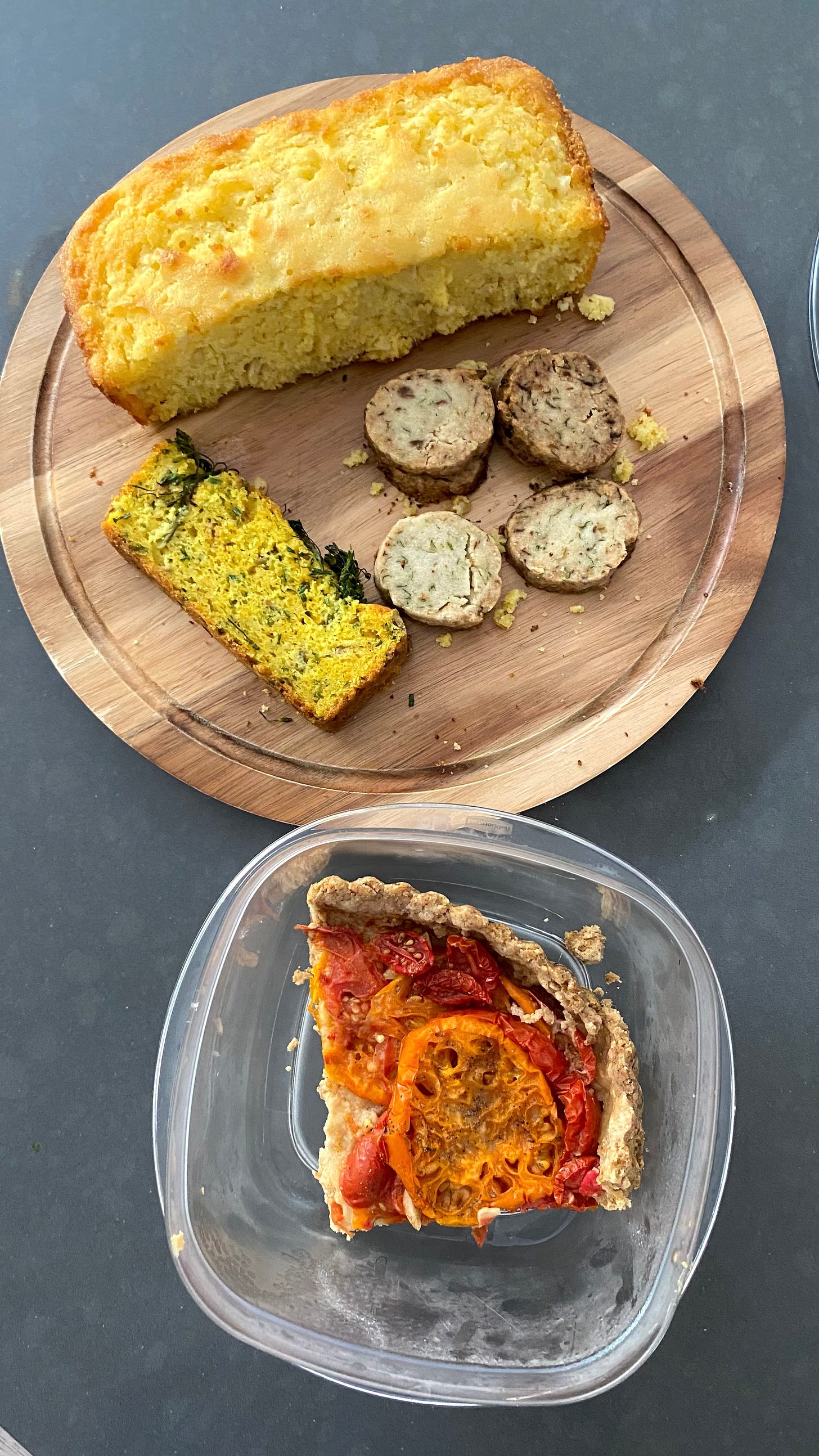
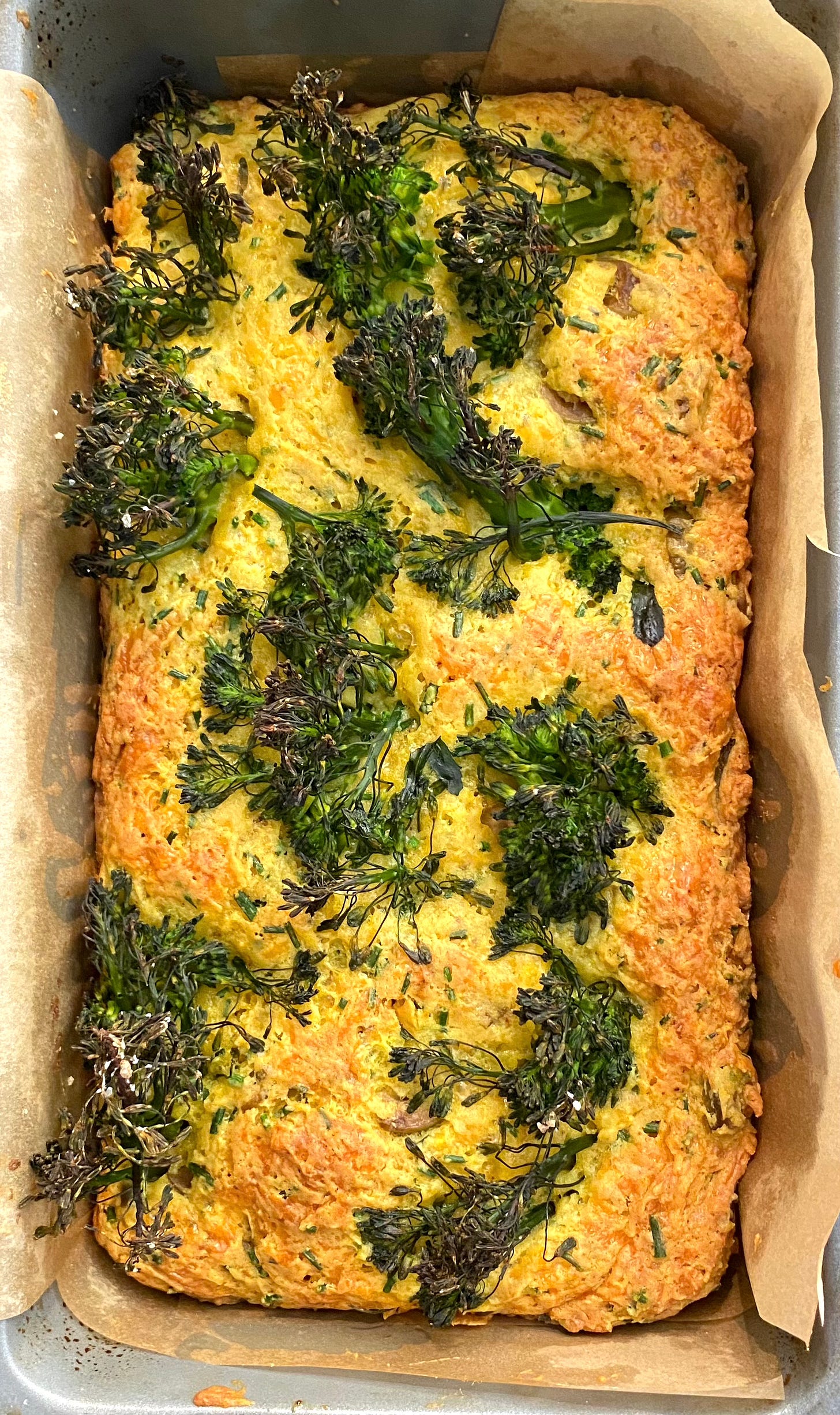
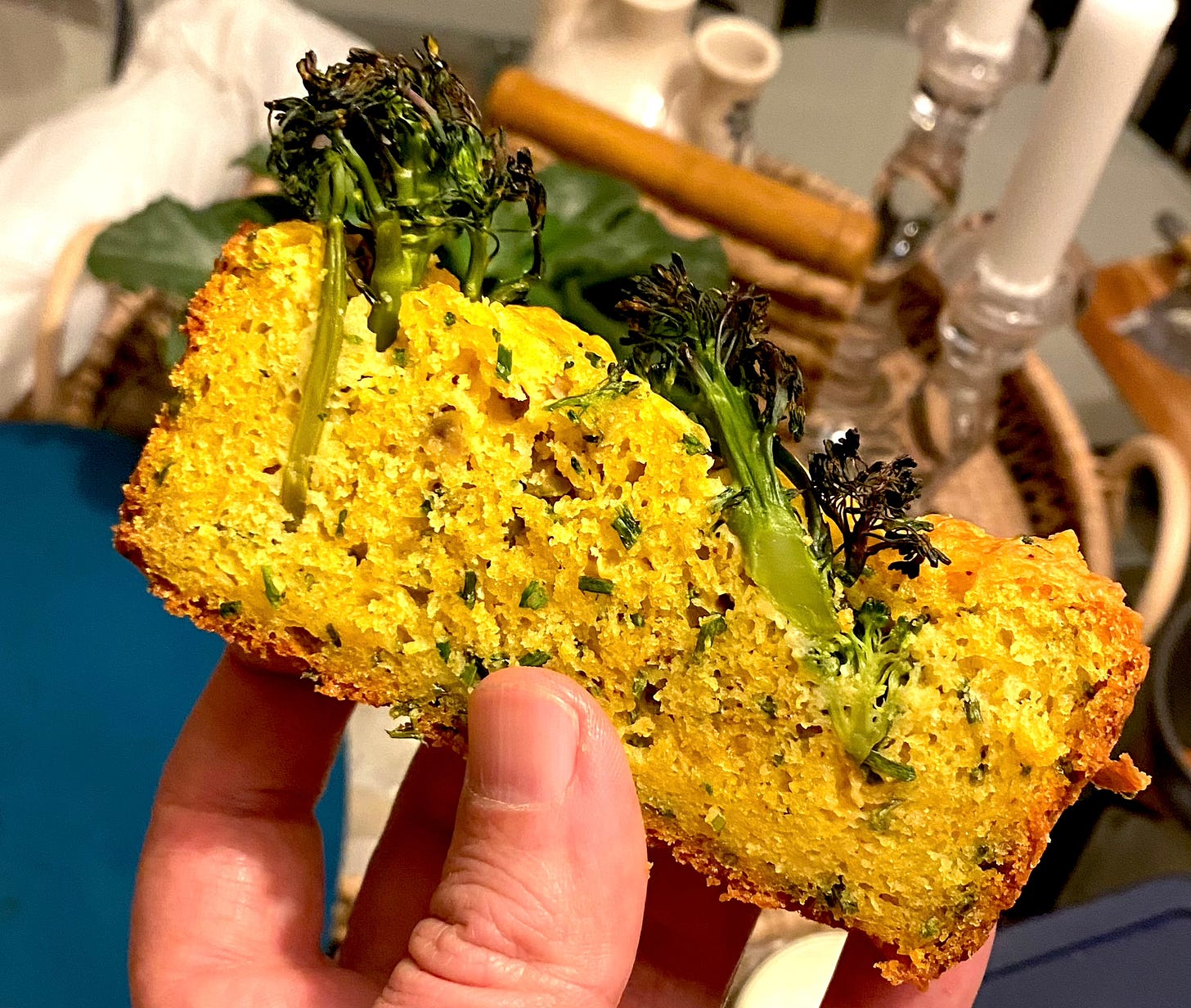
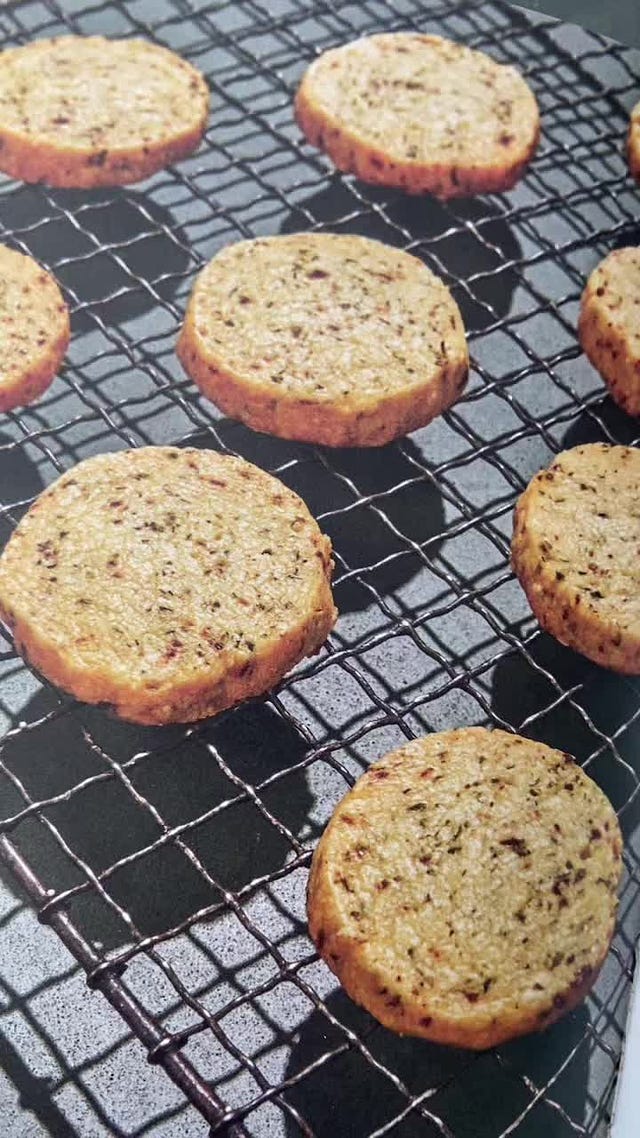

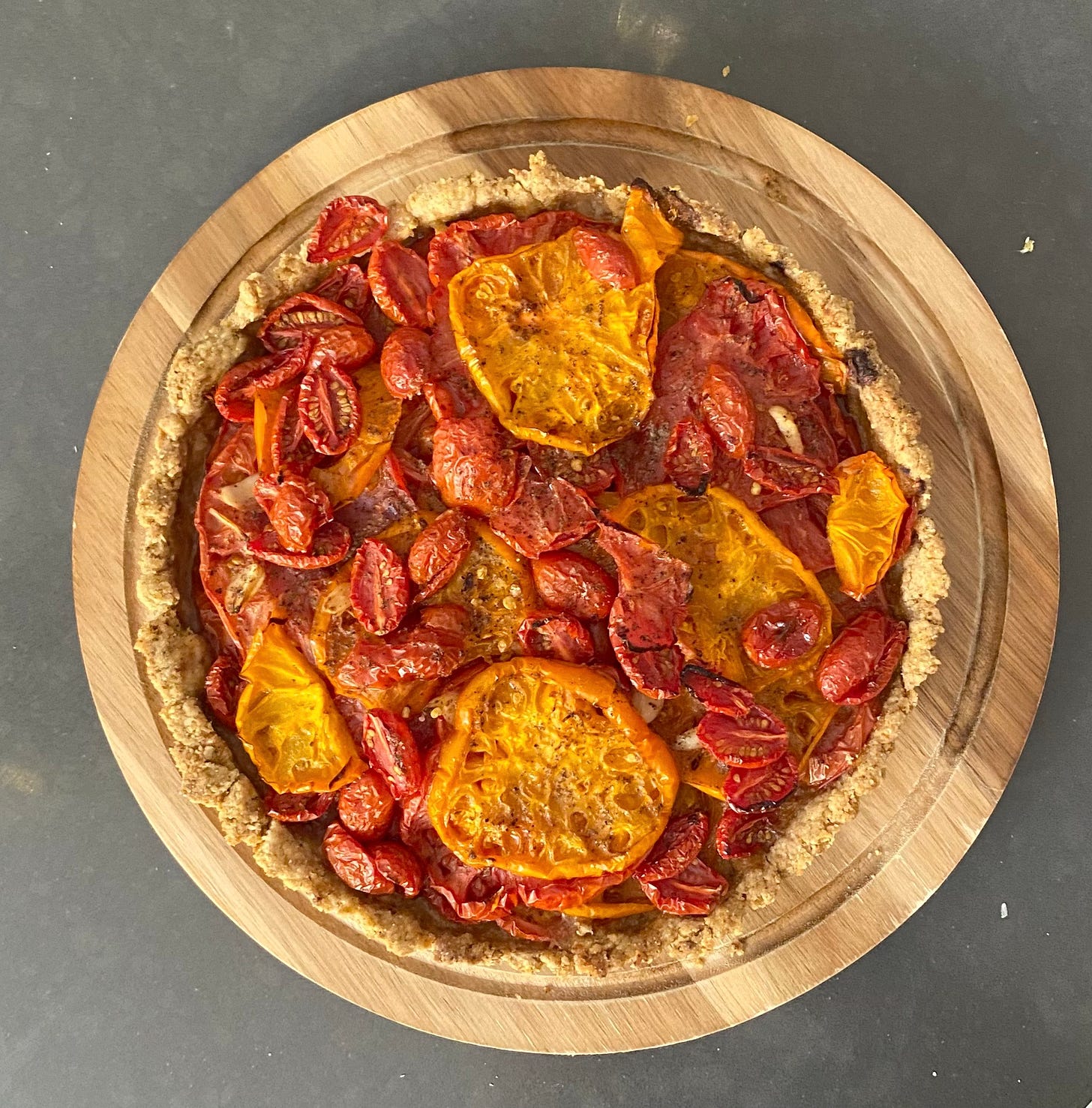
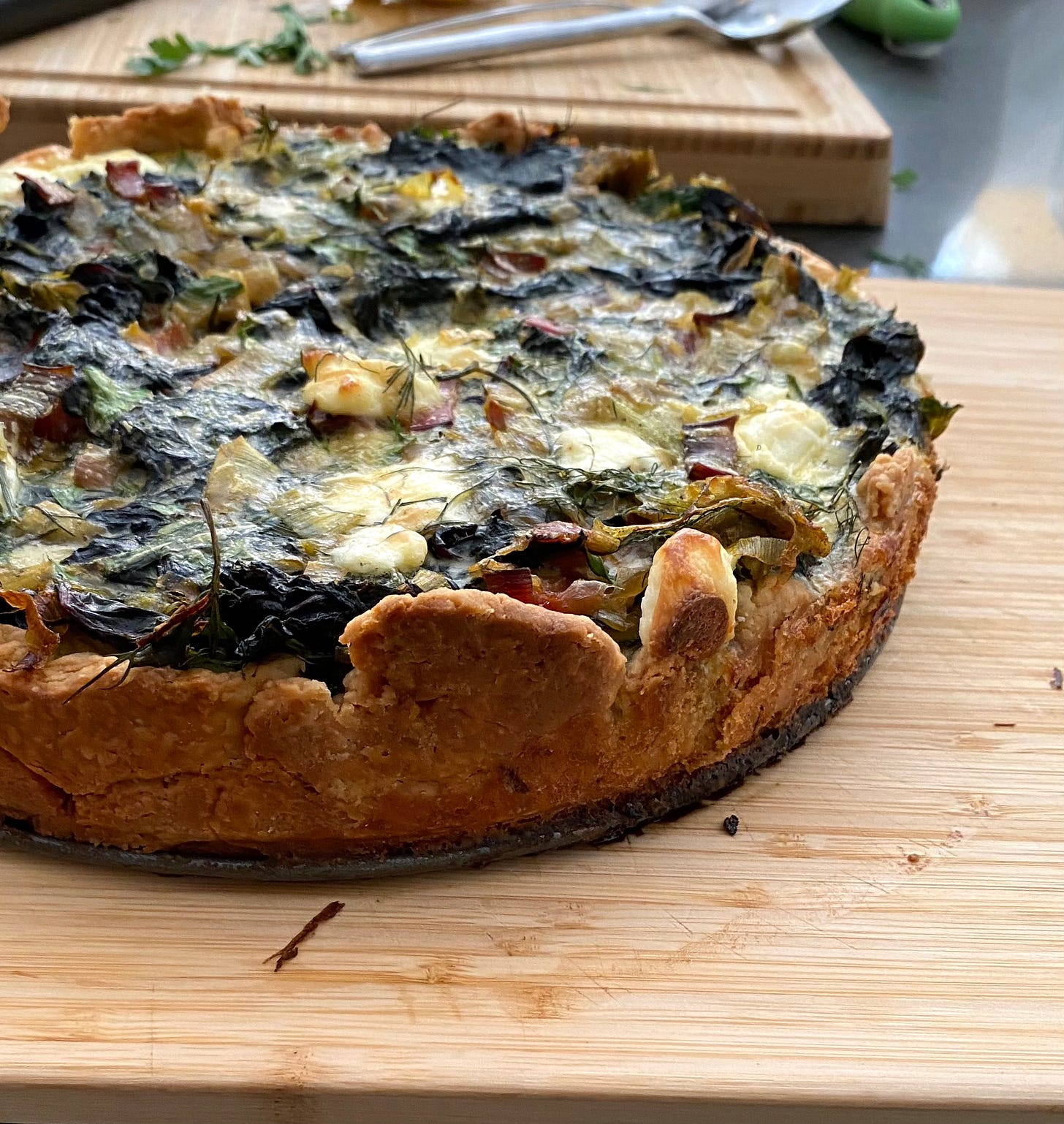
Wowsa - that broccolini loaf looks amazing. Thank you for continuing to share your passions. You and Ronnie are true Renaissance men!
Your anchovy shortbread looks really good! I would 100% make those : )